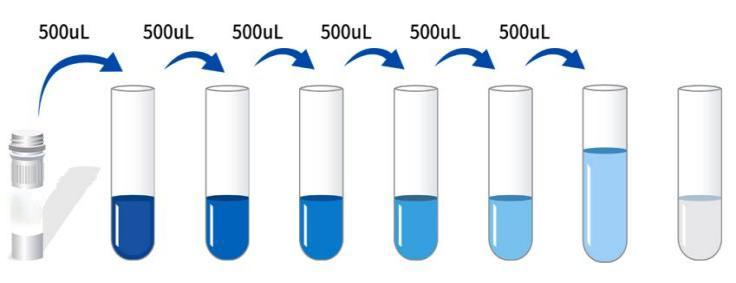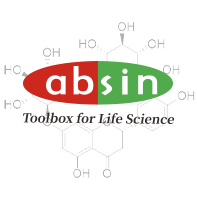Product Details
Product Details
Product Specification
| Usage |
Experimental equipment required for the experiment: 1. Microplate reader (450nm) 2. High-precision pipette and pipette tips: 0.5-10uL, 5-50uL, 20-200uL, 200-1000uL 3. 37℃ constant temperature box 4. Distilled water or deionized water Sample processing and requirements: Recombinant protein Preparation before detection: 1. Please take out the test kit from the refrigerator 10 minutes in advance and equilibrate to room temperature. 2. Prepare the standard working solution gradient: Add 1 mL of universal diluent to the lyophilized standard. Let stand for 15 minutes to completely dissolve, then gently mix (concentration 3000 ng/mL). Then dilute to the following concentrations: 3000 ng/mL, 1500 ng/mL, 750 ng/mL, 375 ng/mL, 187.5 ng/mL, 93.75 ng/mL, 46.875 ng/mL, and 0 ng/mL. Serial dilution method: Add 500 μL of universal diluent to each of seven EP tubes. Pipette 500 μL of the 3000 ng/mL standard working solution into the first EP tube and mix thoroughly to make a 1500 ng/mL standard working solution. Repeat this procedure for subsequent tubes. The last tube serves as a blank well; there is no need to pipette liquid from the penultimate tube. See the figure below for details.  3. Preparation of Biotin-Antibody Working Solution: Centrifuge the concentrated Biotin-Antibody at 1000×g for 1 minute 15 minutes before use. Dilute the 100× concentrated Biotin-Antibody to a 1× working concentration with universal diluent (e.g., 10uL concentrate + 990uL universal diluent) and use on the same day. 4. Preparation of Enzyme Conjugate Working Solution: 15 minutes before use, centrifuge the 100x concentrated enzyme conjugate at 1000×g for 1 minute. Dilute the 100x concentrated HRP enzyme conjugate to a 1x working concentration with universal diluent (e.g., 10µL concentrate + 990µL universal diluent). Use the same day. 5. Preparation of 1x Wash Solution: Dispense 10mL of 20x Wash Solution into 190mL of distilled water (Concentrated Wash Solution removed from the refrigerator may crystallize; this is normal. Allow to stand at room temperature until the crystals have completely dissolved before preparing). Procedure: 1. Remove the desired strips from the aluminum foil bag after equilibration at room temperature for 10 minutes. Seal the remaining strips in a ziplock bag and return them to 4°C. 2. Sample Addition: Add 50 μL of sample or standard of varying concentrations to the corresponding wells. Add 50 μL of universal diluent to the blank wells, followed by 50 μL of Biotin-Antibody Working Solution to each well. Cover with film and incubate at 37°C for 1 hour. (Recommendation: Dilute the sample to be tested at least 1-fold with universal diluent before adding it to the ELISA plate to minimize matrix effects. The sample concentration should be multiplied by the dilution factor when calculating the final concentration. It is recommended to run replicates for all samples and standards.) 3. Plate Wash: Discard the liquid and add 300 μL of 1x Wash Solution to each well. Let stand for 1 minute, then shake off the wash solution and pat dry on absorbent paper. Repeat this process three times (a plate washer can also be used). 4. Enzyme Conjugate Working Solution: Add 100 μL of enzyme conjugate working solution to each well. Cover with film and incubate at 37°C for 30 minutes. 5. Wash: Discard the liquid and wash the plate five times as in step 3. 6. Add substrate: Add 90 μL of substrate (TMB) to each well, cover with a sealing film, and incubate at 37°C in the dark for 15 minutes. 7. Add stop solution: Remove the ELISA plate and add 50 μL of stop solution directly to each well. Immediately measure the OD value of each well at a wavelength of 450 nm. Calculation of experimental results: Result evaluation: 1. Calculate the average OD value of the standard and sample replicates and subtract the OD value of the blank well as a correction value. Plot a standard curve for the four-parameter logistic function on double-logarithmic graph paper with concentration as the horizontal axis and OD value as the vertical axis. 2. If the sample OD value is higher than the upper limit of the standard curve, dilute the sample appropriately and retest. Multiply the sample concentration by the corresponding dilution factor. |
||||||||||||||||||||||||||||||||
| Theory | This kit uses a competitive enzyme-linked immunosorbent assay (ELISA). Sample, standard, biotin-labeled antibody, and HRP conjugate are sequentially added to microwells pre-coated with a universal hemagglutinin tag (HA-tag) antigen. After incubation and washing, the assay is developed using the substrate TMB. TMB is converted to blue by peroxidase (HRP) catalysis and to yellow by acid. The intensity of the color is positively correlated with the amount of universal hemagglutinin tag (HA-tag) in the sample. The absorbance (OD) is measured at 450 nm using a microplate reader to calculate the sample concentration. | ||||||||||||||||||||||||||||||||
| Source | All | ||||||||||||||||||||||||||||||||
| Synonym | Generl Hemagglutinin tag(HA-tag)ELISA Kit | ||||||||||||||||||||||||||||||||
| Detection Type | Competition Law | ||||||||||||||||||||||||||||||||
| Composition |
|
||||||||||||||||||||||||||||||||
| Background | The hemagglutinin tag (HA-tag) is a 9-amino acid polypeptide derived from residues 90-106 of the human influenza virus HA molecule. It is a surface glycoprotein with a molecular weight of approximately 63 kDa associated with human viral infection of cells. It is widely used as an epitope tag in expression vectors, facilitating protein detection, isolation, and purification. Many recombinant proteins can express the HA tag because it does not interfere with the protein's biological activity or biodistribution. | ||||||||||||||||||||||||||||||||
| General Notes | 1. Strictly adhere to the specified incubation time and temperature to ensure accurate results. All reagents must be at room temperature (20-25°C) before use. Refrigerate reagents immediately after use. 2. Improper plate washing may result in inaccurate results. Ensure that all liquid in the wells is aspirated thoroughly before adding substrate. Do not allow the wells to dry out during incubation. 3. Remove any residual liquid and fingerprints from the bottom of the plate, as this will affect the OD value. 4. The substrate developer solution should be colorless or very light in color. Do not use substrate solution that has turned blue. 5. Avoid cross-contamination of reagents and specimens to prevent erroneous results. 6. Avoid direct exposure to strong light during storage and incubation. 7. Do not expose any reagents to bleaching solvents or the strong fumes emitted by bleaching solvents. Any bleaching agent will destroy the biological activity of the reagents in the kit. 8. Do not use expired products, and do not mix components with different product numbers and batches. 9. Recombinant proteins from sources other than the kit may not be compatible with the antibodies in this kit and will not be recognized. 10. If there is a possibility of disease transmission, all samples should be managed properly and samples and testing devices should be handled according to prescribed procedures. |
||||||||||||||||||||||||||||||||
| Storage Temp. | If the unopened kit is stored at 4°C, the shelf life is 6 months. | ||||||||||||||||||||||||||||||||
| Test Range | 12.34-3000ng/mL | ||||||||||||||||||||||||||||||||
| Applications | recombinant protein |


